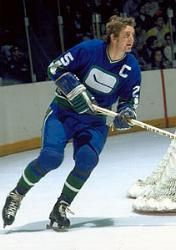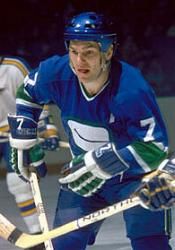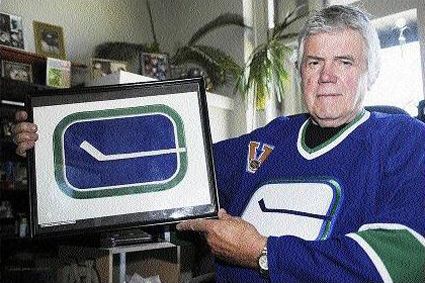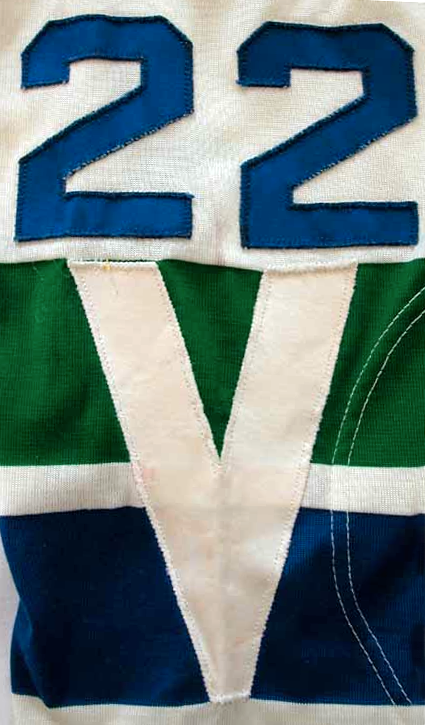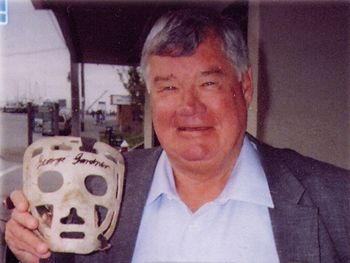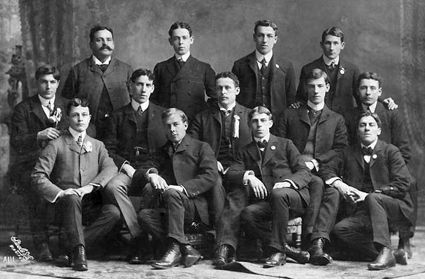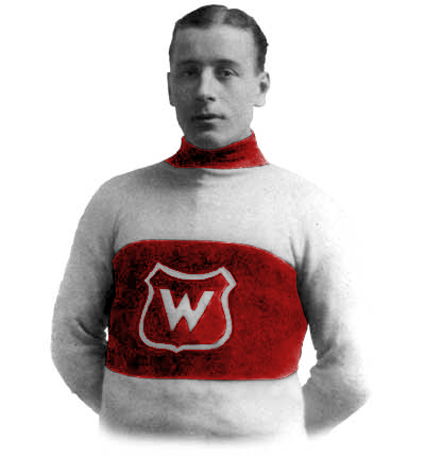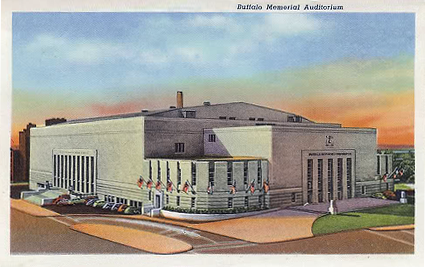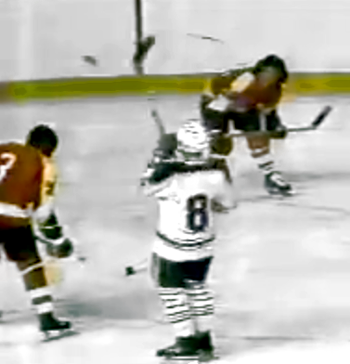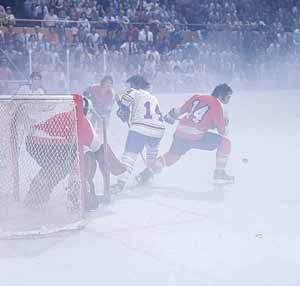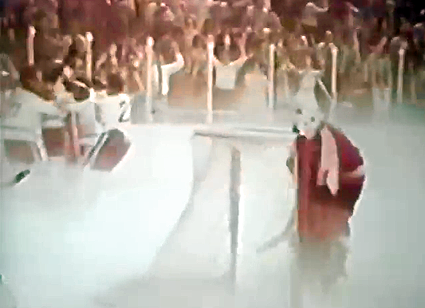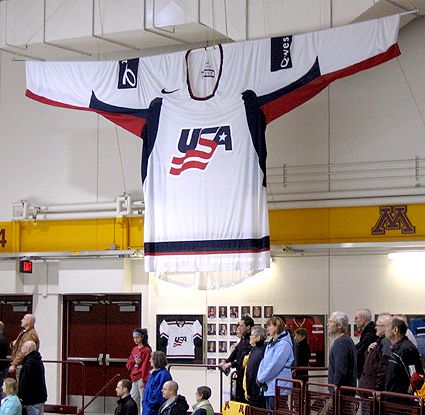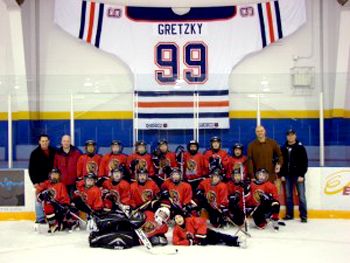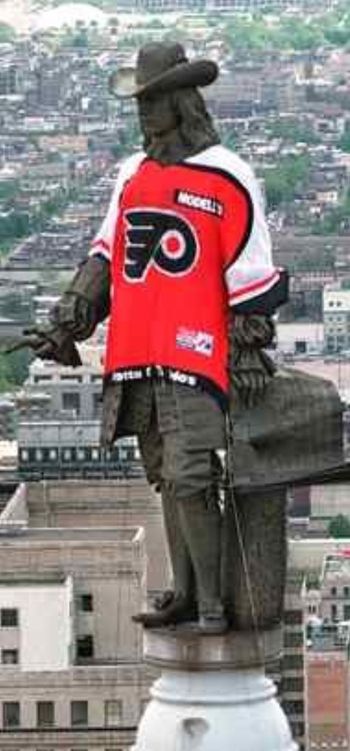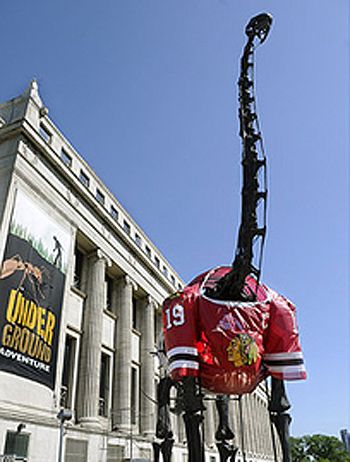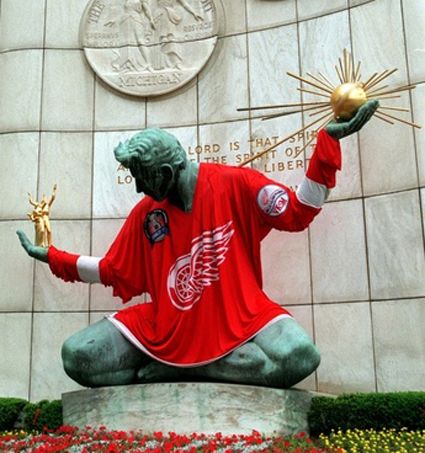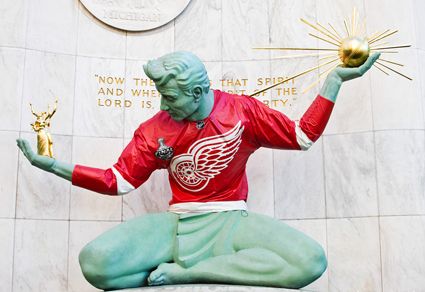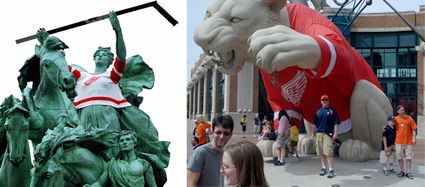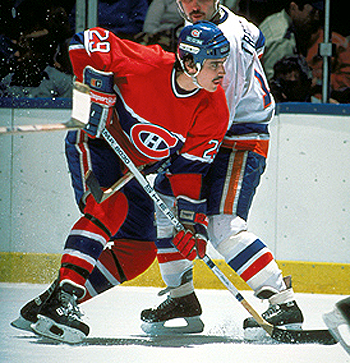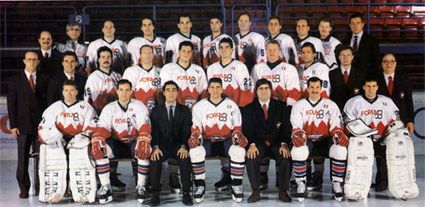Saturday, May 22, 2010
1970-71 Vancouver Canucks Garth Rizzuto Jersey
Since the demise of the Brooklyn Americans in 1942, the NHL consisted of just six member teams, commonly referred to as "The Original Six". Finally, following the success of the Los Angeles Dodgers and San Francisco Giants in Major League Baseball on the west coast, the idea of expanding the NHL was first brought up in 1963, partly due to fears that the Western Hockey League was intending to operate as a major league in the near future and also in hopes of making the league more attractive to American television networks with coast-to-coast appeal.
The original discussions promoted San Francisco and Vancouver as acceptable locations with Los Angeles and St. Louis also as potential candidates in March of 1965.
In February of 1966, applications were received from groups from Los Angeles, Pittsburgh, Minnesota, Philadelphia, San Francisco, Baltimore, Buffalo and Vancouver.
In the end, franchises were awarded to Oakland (across the bay from San Francisco), Los Angeles, Minnesota, Philadelphia, Pittsburgh and... St. Louis.
The decision to exclude Vancouver caught many by surprise, especially those involved in the construction of the brand new Pacific Coliseum in Vancouver, and angered not only the locals, but all of Canada, since the six chosen cities were all in the United States. Various reasons emerged to explain the surprise inclusion of St. Louis, despite the fact there was no formal proposal from a group representing St. Louis!
Reportedly, Toronto and Montreal did not want to share Canadian TV revenues with a third club and support for expansion from Chicago was contingent on the creation of a team in St. Louis, which would result in the sale of the run-down St. Louis Arena, which just conveniently happened to be owned by the Chicago Black Hawks ownership group at the time...
Less than a year later the Oakland Seals franchise was having financial difficulties and an apparent deal was struck to move the club to Vancouver. The NHL however, did not want to see one of their brand new franchises moved so quickly and killed the deal. In exchange for avoiding a lawsuit, the NHL promised Vancouver a team in the next expansion, which occurred on this date in 1970, when Buffalo and Vancouver were granted entry into the NHL, at a cost of $6 million, three times the cost in 1967.
The first order of business was selecting a name for the new Vancouver franchise, and they chose to retain the name Vancouver Canucks, which had been in use by the Vancouver club in the WHL from 1952 to 1970. The club's original colors of Blue, white and green were chosen to represent the water, the snow and the mountains which surround Vancouver.
During the Expansion Draft on June 9, 1970, the Canucks chose Gary Doak, a defenseman from the Boston Bruins. Their second choice was Orland Kurtenbach, a center from the New York Rangers who became the Canucks first team captain. After chosing Ray Cullen, the Canucks selected Pat Quinn, who would one day return to coach the Canucks.
Orland Kurtenbach
Two days later, the league held it's annual Amateur Draft. The Sabres famously won the spin of a wheel to win the right to select first, leaving the Canucks with the second choice, which they used on defenseman Dale Tallon, who would play in Vancouver for three seasons.
The rest of their draft was less than successful, with forgotten names such as defenseman Jim Hargreaves (66 total games with Vancouver), goalie Ed Dyck (49 games) plus Brent Taylor, Bill McFadden and Dave Gilmour, all of whom never skated in the NHL.
The Canucks played their first game on October 9, 1970 against the Los Angeles Kings, with former Vancouver Millionaires player (1912-1921), the 86-year-old Cyclone Taylor, in attendance. Barry Wilkins had the distinction of scoring the first goal in team history. The Canucks first victory arrived two days later, as they exacted a measure of revenge for their delay in getting into the NHL on the Toronto Maple Leafs with a 5-3 win.
The Canucks would play respectable hockey for the first three months of the season until Kurtenbach was sidelined with a knee injury in late December with the team at 13-18-3 at the time. They would win only one game in January and just three in February to find themselves at 18-37-6, with the low point being allowing three goals to Boston in just 20 seconds on February 25th. They finished out the season 6-11-2 after Kurtenbach's return for a season record of 24-16-8 for sixth place in the tough East Division with five of the well established Original Six franchises as competition.
The team was led in scoring by Andre Boudrias, who had 25 goals and 41 assists for 66 points. Rosaire Paiement led the team in goals with 34, as well as penalty minutes with 152. In all, six Canucks had 20 goals or more, with Boudrais and Wayne Maki tied for second with 25 and Murray Hall, Kurtenbach and Mike Corrigan each with 21. Tallon broke the Bobby Orr's rookie record for assists by a defenseman with 42. Charlie Hodge led the goaltenders with 15 wins.
Andre Boudrias
Today's featured jersey is a 1970-71 Vancouver Canucks Garth Rizzuto home jersey. Rizzuto played 37 games for the Canucks in 1970-71, scoring 3 goals and 7 points. He later played two seasons for the Winnipeg Jets of the WHA.
The Canucks original "stick in rink" logo was designed by a local designer Joe Borovich and used until 1978 before being dropped in favor of the highly controversial "Flying V" style.
The original logo made a return in 2003 as a shoulder patch on the home and road jerseys as well as on the front of the club's vintage jerseys, worn occasionally for two seasons prior to it becoming the third jersey for 2006-07.
After designing the logo, Borovich was then asked to be involved with the design of the club's original jerseys as well. The "V" on the sleeve stripes only lasted two seasons before being removed when the sleeve and waist stripes were redesigned.
Bonus Jersey: Today's bonus jersey is a 1970-71 Vancouver Canucks George Gardner jersey.
Gardner played 11 professional seasons as a goaltender with a variety of clubs, seeing action in 66 games with the Detroit Red Wings and Vancouver Canucks of the NHL and 79 games with the Los Angeles Sharks and Vancouver Blazers of the WHA in addition to six different minor league teams.
Gardner displaying his old goalie mask
Today's video section begins with a little "old time hockey" from the Canucks early days. We believe the first one is from the 1970-71 season, but can't get a clear look at the sleeves of the jerseys long enough due to the speed of the punching to confirm the V shapes!
This second one is clearly from the first two seasons, and features Pat Quinn adding to his penalty minute total.
Unfortunately for Canucks fans, we found footage of the Bruins scoring their three goals in 20 seconds. You may get a good look at the Canucks jerseys as they tend to be standing around and watching according to the announcers.
To hear an interview with the designer of the Canucks original logo, click below.
Labels:
Gardner George,
Rizzuto,
Vancouver Canucks
Friday, May 21, 2010
1909-10 Montreal Wanderers Jimmy Gardner Jersey
Born on this date in 1881, Jimmy Gardner began his hockey career with the Montreal Hockey Club. The club was affiliated with the Montreal Amateur Athletic Association and is commonly referred to as "Montreal AAA" in the record books.
He first skated for the club during a game in the 1900-01 season and then played in all eight games of the 1901-02 season, helping the Montreal Hockey Club to a 6-2 record and a first place finish. Their first place finish earned them the right to challenge the Winnipeg Victorias for the Stanley Cup. The best-of-three series was held in Winnipeg with the Victorias taking Game 1 by a score of 1-0. Montreal came back strong in Game 2, evening the series with a dominant 5-0 win and won their challenge with a narrow 2-1 win in the decisive Game 3. The much larger Winnipeg team hit the players from Montreal again and again in the series, but refused to be run out of the building, earning them the nickname "The Little Men of Iron".
1902 Stanley Cup Champions the Montreal Hockey Club
A challenge for the cup arrived from the Winnipeg Victorias in January of 1903, with the first game held in Montreal on January 29th. Montreal easily won the first game by a score of 8-1 with the second game ending in a 2-2 tie after it was suspended after 27 minutes of overtime due to a curfew. Winnipeg evened the series with a 4-2 win before Montreal successfully defended the cup with a 4-1 win to take the series 2 games to 1 with Gardner scoring a goal in the series.
For the 1903-04 season, Gardner moved to the brand new Montreal Wanderers of the Federal Amateur Hockey League, dominating the league with a 6-0 record. Gardner scored 5 goals in the six games. As winners of the league, the Wanderers earned the right to challenge the Ottawa Senators for the Stanley Cup. The first game in Montreal reached the end of regulation tied at 5-5 and the Wanderers refused to play the overtime with the same referee in charge! The trustees of the cup ordered the series restarted with both games scheduled for Ottawa, but Montreal refused and the series never resumed.
Gardner turned professional for the 1904-05 season, skating for the Calumet Miners of the International Hockey League, where he scored 16 goals in 23 games. He returned to Calumet in 1905-06 before playing for the Pittsburgh Professionals, also of the IHL, in 1906-07, where he scored 10 goals and 18 points in 20 games.
Gardner - 1906-07 Pittsburgh Pros
He returned to Montreal for the 1907-08 season, this time with the Shamrocks, who finished in last place. Gardner then rejoined the defending Stanley Cup holders, the Montreal Wanderers for the 1908-09 season, in which he scored 11 goals in 12 games.
Prior to the start of the 1909-10 season, the Wanderers would face a challenge for the Stanley Cup from the Edmonton Hockey Club, whom they would defeat 13-10 in a two-game total-goal series 7-3 and 7-6. With the 1909-10 season underway, Gardner contributed 10 goals in 12 games as the Wanderers dominated with an 11-1 record and took possession of the Stanley Cup. They then defended against a challenge from the Berlin Dutchmen of the Ontario Professional Hockey League by a score of 7-3 to earn Gardner his fourth Stanley Cup.
1910 Stanley Cup Champions Montreal Wanderers
After another season with the Wanderers, Gardner moved out west to play for the New Westminster Royals of the Pacific Coast Hockey Association, scoring 11 goals in 28 games over two seasons.
Once more, Gardner would return to Montreal, this time with the Canadiens, for whom he was named team captain. He played the 1913-14 season with 19 points in 15 games and then played two games in 1914-15 to close out his playing career.
He then went on to become a referee as well as being a coach before being inducted into the Hockey Hall of Fame in 1962.
Today's featured jersey is a 1909-10 Montreal Wanderers Jimmy Gardner jersey. The Wanderers jerseys featured a wide red band across the chest, which would have eventually become as iconic as the jerseys of the Canadiens had the club survived.
The Wanderers were originally founded in 1903 as a result of a dispute over control of the Montreal Hockey Club, and many of it's original roster came from the Montreal AAA.
The Wanderers would hold the Stanley Cup during it's challenge days at various times in 1906, 1907, 1908, 1909 and 1910, including five straight defenses from March 1907 to December 1908.
As was the case in the early days of organized hockey, the Wanderers shifted from league to league, eventually becoming a member of the National Hockey Association and then became one of the founding members of the National Hockey League in 1917. Unfortunately, after only four games of play in the new league, the Wanderers home rink, the Montreal Arena, burned down on January 2, 1918 and the team ceased operations.
Labels:
Gardner Jimmy,
Montreal Wanderers
Thursday, May 20, 2010
1974-75 Buffalo Sabres Rene Robert Jersey
In 1973-74, the Buffalo Sabres had finished mid-pack and missed out on the Stanley Cup playoffs. They rebounded strongly in 1974-75, winning the newly created Adams Division and finishing tied with the defending Stanley Cup Champions, the Philadelphia Flyers and also the Montreal Canadiens with 113 points.
The Sabres, led by The French Connection line, which consisted of Rene Robert (with a team leading 100 points), Gilbert Perreault (96 points) and Rick Martin (95 points), defeated the Chicago Black Hawks 4 games to 1 in the quarterfinals before ousting the Canadiens 4-2 to reach their first Stanley Cup Finals in only their fifth season of play.
Game 1 of the finals, the first without an Original Six team since 1926, was played in Philadelphia's Spectrum and went to the Flyers 4-1. Philadelphia also took Game 2 by a close 2-1 margin.
The series then moved to the Buffalo Memorial Auditorium for Game 3 on this date in 1975, which would prove to be one of the strangest games in NHL history.
"The Aud" was originally constructed in 1940, the building was renovated with the arrival of the Sabres and Buffalo Braves of the NBA in 1970.
"The Aud" was originally constructed in 1940, the building was renovated with the arrival of the Sabres and Buffalo Braves of the NBA in 1970.
Early in Game 3, a bat was spotted flying near ice level during the game. Finally at one point, with the teams line up for a face off in the Flyers zone, with the bat buzzing the players heads, Jim Lorentz raised his stick and swatted the bat out of midair and Rick MacLeish of the Flyers picked up the dead creature and deposited it over the boards at the Flyers bench.
As time passed, the sell out crowd of over 16,000 fans began to have an effect, as the non-air conditioned arena began to get warmer and steamier. Temperatures at ice level eventually got so warm that a layer of fog began to appear on the ice.
Eventually, the fog became thicker and thicker, causing the officials to halt play several times because the players could not see halfway down the ice. Several attempts were made to deal with the fog, including having the players skate in circles to try to stir up the air and clear the fog, as well as having the arena staff quickly raise and lower bed sheets to move larger amounts of air with some effect.
Play was resumed, but then stopped again and again and the visibility remained poor. Eventually both coaches, Fred Shero of the Flyers and Floyd Smith of the Sabres instructed their players to shoot as often as possible since the opposing goaltender was going to have problems seeing the puck.
Down by two goals, the Sabres fought back with a pair of goals by Danny Gare and Martin just 17 seconds apart to even the score at 2-2 before the struggling Sabres goaltender Gerry Desjardins let in a shot by MacLeish from 40 feet to put the Flyers back in the lead at the end of the first period.
During the intermission, Desjardins asked to be relieved in the Sabres goal. "After the second goal against me, I thought it was a grand time to get the hell out of there. I knew if I had stayed in, everything would have gone down the drain," Desjardins said following the game. "After all, we were only down by one goal. It was close at the end of the first period, Why waste it?"
During the second period, Reggie Leach scored on his own rebound after a wild scramble in front of new Sabres goalie Roger Crozier to give the Flyers a 4-2 lead, but Don Luce was able to put one past Bernie Parent to send the game into the third with Philadelphia up 4-3.
During the third period, defenseman Bill Hajt of Buffalo put in a rebound of a shot by Martin to even the score and eventually send the game into overtime.
The fog continued to disrupt play in overtime, causing seven stoppages. Finally, with about a minute to play, Perreault skated into the Flyers zone and passed the puck to Robert in the far corner. Robert, along the goal line, shot the puck from the sharp angle, which eluded Parent and went between his legs for the winning goal for the Sabres after nearly 80 minutes of play, sending the crowd into a frenzy.
"I didn't see Perreault's pass," said Parent. "I saw Robert's shot too late for me to come out and stop it. I'm surprised he overtime took so long. It was hard to see the puck from the red line. If three men came down and made a good pass from the red line, you couldn't see the puck. A good shot from the red line could have won it. But it was the same thing for Crozier."
"There had been a lot of pressure on our line," Robert said. "People saw we scored so many goals during the season, what has happened to us now, that we're letting down, the we don't check. Philadelphia double shifts our line, you know, and they are a real good team, too. Getting a big goal like that makes you feel good. It has been tough for us."
Today's featured jersey is a 1974-75 Buffalo Sabres Rene Robert jersey as worn when he scored the winning goal in overtime of the "Fog Game" in the 1975 Stanley Cup Finals.
The original Sabres jerseys, worn from 1970-71 to 1976-77 featured a lace-up collar and no names on the back, unless it was for a national TV game, in which case names were added and then removed afterwards, as the club owners felt that not having names on the backs of the jerseys would lead to increased program sales.
Our video section today begins with highlights of the bat attack and the eventual fog bank which descended over the ice.
This look at the history of "The Aud" includes footage of Robert's overtime goal in the fog.
History Will Be Made - Jim Lorentz.
Labels:
Buffalo Sabres,
Robert Rene
Wednesday, May 19, 2010
Giant Hockey Jerseys
Born on this date in Grenoble, France in 1946, Andre Rene Roussimoff is better known to the world as former professional wrestler Andre the Giant. The third of five children, Andre did not show any signs early on that he would grow to such oversized proportions brought on by acromegaly, a disease which results in excessive growth hormones. While the rest of his siblings ceased growing at the usual age, Andre's body continued to grow, and at the age of 12, he stood 6 feet, 3 inches tall.
He started to make a name for himself wrestling in France where he came to the attention of French-Canadian wrestler Edouard Carpentier, who convinced Andre to make the move to North America, where he moved from the undercard to headliner, performing in front of 20,000 fans in Montreal.
This level of success brought Andre to the attention of Vince McMahon, Sr., head of the World Wide Wrestling Federation, who not only signed him to a contract in 1972, but dubbed him "Andre the Giant". He was now selling out venues such as Madison Square Garden in New York and making appearances in the Boston Bruins dressing room!
Andre, reportedly 7 feet, 4 inches and 500 pounds, easily hoists Carol Vadnais (6' 1", 190 lbs.) and Bobby Orr (5' 11", 200 lbs.)
Phil Espostio explains how the photo came to be in his book "Thunder and Lightning", some of which we can repeat here.
"Carol Vadnais was acquired in a trade with the California Golden Seasls late in the 1971-72 season. We were skating around the Boston Garden during the warm-up before a game, and in the stands behind the net was this huge man with a gigantic head and an afro haircut. I had never seen anyone like him in my life.I said, "Who the hell is that? Look at that guy!"Vad said, "That's my buddy, Andre the Giant.""The wrestler?" I asked."Yeah," he said.After the game Andre came into the dressing room. I used to have a picture of Andre holding me up in one arm and Bobby Orr in the other.We knew this girl who was gorgeous, but who loved the Bruins so much she would do absolutely anything for us, and we fixed her up with Andre. We all went out after the game to have drinks. We were in a place on Commonwealth Avenue that had a bar and a swimming pool inside. I'll tell you how big Andre was. He ordered a beer, and when he held it, he only needed two fingers to cover that can of beer.At one o'clock the manager came and asked us all to leave. We were all together, and Bobby Orr said something to Andre, and Andre picked the guy up and threw him into the swimming pool! The cops came and we left."
His fame, as well as his frame, continued to grow, as Andre was paired with boxer Chuck Wepner in a 1976 "boxer vs. wrestler" match at Shea Stadium in New York in front of over 35,000 fans, which ended with Andre tossing the 6' 5" Wepner out of the ring. Andre was also the subject of a Sports Illustrated article in 1981, the kind of appeal and mass recognition that few, if any, professional wrestlers had ever achieved at that point.
Eventually Vince McMahon, Jr. would take control of the WWWF wrestling empire, shorten the name to the WWF and create the first nation-wide wrestling promotion, of which the crown jewel was "WrestleMainia". For WrestleMania III in 1987, in the headline match saw Andre the Giant squared off against Hulk Hogan at the Pontiac Silverdome in Michigan in front of a sold out crowd of 93,173 and generated $10 million in pay-per-view sales. He eventually became the WWF Heavyweight Champion.
Despite the increasing issues with his health, he continued to wrestle and later make appearances ringside until 1992. In 1993, when the WWF created it's Hall of Fame, Andre the Giant was the very first, and only, inductee that year.
He also crossed over into television and movie roles, well known for his portrayal as Sasquatch in the TV series "The Six Million Dollar Man" and most notably for his role as "Fezzik" in the movie "The Princess Bride".
Andre passed away at the age of 46 in his sleep from a heart attack on January 27, 1993 in Paris, France.
In honor of Andre the Giant, today we take a look at some giant hockey jerseys.
Most recently, the United States Women's Olympic team toured with an oversized promotional jersey in their Qwest Tour exhibition season leading up to the 2010 Olympics in Vancouver. There were actually two of them made by Nike at a cost of $1,000 each. Aside from the fact the jerseys are 26 feet wide from cuff to cuff and 17 feet tall, they are the same as a regular jersey, only on a much bigger scale.
Another notable jersey, 10 feet tall and 20 feet wide, is an Edmonton Oilers Wayne Gretzky jersey made for the Wayne Gretzky Fantasy Camp VII in 2009, which consists of 23 yards of fabric, compared to three for a normal jersey, which took seamstress Patsy Elmer approximately 35 hours to complete. After the conclusion of the fantasy camp, the jersey now resides in the Frank Lacroix Arena in Fort McMurray, Alberta.
Another enormous jersey decorated the statue of William Penn on top of City Hall in Philadelphia, Pennsylvania in 1997 when the Flyers made it to the Stanley Cup Finals. The statue measures 37 feet tall, making the jersey 16 feet tall in our estimation.
The Field Museum in Chicago has gotten on the Blackhawks bandwagon, dressing their three story high cast iron Brachiosaurus statue in a Jonathan Toews jersey for the playoffs recently.
Perhaps the most famous oversized jersey is the Detroit Red Wings jersey, traditionally used to dress the 26 foot tall Spirit of Detroit statue in downtown Detroit since they made the finals in 1997. The jersey has actually undergone several variations, including sporting the 1998 Stanley Cup Finals and Believe patches, a very nice touch and great attention to detail.
In 2009 the statue was dressed in a new, undersized and absurdly tight Reebok jersey, more fitting for Johnny Weir than Johan Franzen, which will apparently make the Spirit of Detroit 9% faster than before...
If you are aware of any additional oversized hockey jerseys, we'd love to hear about them. Either post them in the comments below, or email us with the details.
Today's video section kicks off with the Spirit of Detroit getting dressed for the 2009 Stanley Cup Finals. Or is it the 2009 US Figure Skating Championships?
Next up is the famous match between Andre the Giant and Hulk Hogan from WrestleMania III.
Here are recollections by those involved in the movie of Andre playing "Fezzik" in the Princess Bride.
Does Andre the Giant have a connection to a current NHL team captain? Here is evidence that suggests there very well may be one...
Dasherboard: While the NHL playoffs have certainly seen their share of upsets, with the top three seeds in the East being knocked out in the first round and the 7th and 8th teams meeting in the conference final to determine who goes to the Stanley Cup Finals, the World Championships in Germany have also seen some very surprising results to date.
With the Preliminary Round seeing Canada losing to Switzerland, the Czech Republic losing to Norway and the United States being beaten by Germany, there was no bigger unexpected result than Denmark shocking first Finland 4-1 and then outlasting the USA 2-1 in overtime to send the Americans to the relegation round, guaranteeing their worst finish since 2003.
The Relegation Round went as expected, with the USA winning easily over Kazakhstan and France before being taken to a shootout with Italy to remain secure in the Top Division for 2011 while Italy and Kazakhstan drop down to Division I for next year.
In general, the Qualification Round saw the expected teams advance to the Playoff Round, which begins tomorrow. With several of the games from the Preliminary Round carrying over, several teams had a head start in the standings, such as Switzerland's wins over Latvia and Canada and Russia's wins over Slovakia and Belarus.
Once the Group E and F games began anew, Denmark continued to surprise, demolishing a surprisingly poor Slovakia 6-0, Switzerland remained strong defeating the Czech Republic 3-2 before suffering a defeat at the hands of Norway. Canada has also been mediocre, losing to Sweden and the Czech Republic and only advancing to the Playoff Round by winning a tie breaker against Norway!
The Quarterfinals thus produce some very interesting matchups, with Finland vs. the Czech Republic while Denmark looks to advance against their Scandinavian neighbors Sweden in the early games.
The late games have Switzerland taking on hosts Germany while what is usually a Final or Semifinal matchup, sees Canada looking to save their tournament against what must be a rather heavily favored Russia, who will clearly have their drubbing by Canada in February at the Olympics fresh in their minds.
The four winners will meet in the Semifinals on Saturday with the bronze medal game followed by the Championship Final on Sunday in Cologne.
Labels:
Andre the Giant,
Giant Jerseys
Tuesday, May 18, 2010
1999-00 Frankfurt Lions John Chabot Jersey
Born on this date in 1962, John Chabot, an Algonquin Aboriginal, played in the Quebec Major Junior League for the Hull Olympiques after being drafted first overall in the 1979 QMJHL draft. In his first season with Hull, Chabot scored 26 goals and 57 assists for 83 points in 68 games. Following that season, he was selected by the Montreal Canadiens 40th overall in the 1980 NHL Entry Draft. He exceeded his point totals in all categories the following year with 27 goals, 62 assists and 89 points.
The 1981-82 season saw Chabot move to the Sherbrooke Beavers, where he raised his game with a new high of 34 goals, but exploded in the assist category with a remarkable 109 in 62 games to lead the league, giving him 143 points for the season. He was named the winner of the CCM QMJHL Player of the Year as well as the recipient of the Michel Briere Memorial Trophy as league MVP, an award won by Dale Hawerchuk and Denis Savard in the two previous seasons and in subsequent seasons by Pat Lafontaine and Mario Lemieux.
He spent the 1982-83 season in the American Hockey League with the Nova Scotia Voyageurs proving he was ready for the NHL with 89 points in 76 games.
His NHL debut came in 1983-84 with the Canadiens, dressing for 56 games, scoring 18 goals and 43 points plus seeing action in 11 playoff games.
Ten games into the following season Chabot was dealt to the Pittsburgh Penuins, where he racked up assists on a regular basis to finish the season with 60 points from 51 assists in 77 games.
After another season with the Penguins, Chabot signed with the Detroit Red Wings as a free agent for the 1987-88 campaign. There, he scored an NHL career high 57 points from 13 goals and 44 assists, plus an additional 19 points in 16 playoff contests as the Red Wings advanced to the conference finals.
Chabot had a rough season in 1988-89, playing only 52 games with Detroit and registering a meager 12 points, as well as an eight game stint with Adirondack in the AHL, where he scored just under two points a game.
He found his game again in 1989-90, playing the full season in Detroit and scoring 49 points in 69 games, but 1990-91 was split between Adirondack and Detroit, with 27 games for each, scoring the final 10 points of his NHL career.
1991-92 saw him appear in eight games for the Canadian National Team before moving to Italy with HC Devils Milano, where he dominated with 45 points in 17 games before adding 17 points in 13 playoff games as Milan won the Italian Serie A championship.
After beginning the season with Milan, Chabot moved to the Berlin Capitals of the German Bundesliga. He would play for the Capitals for five seasons, which saw the formation of the new Deutsche Eishockey Liga (DEL) in 1994, and average 1.37 points per game, with a high of 81 points in 50 games.
The 1997-98 season had Chabot on the move to the Frankfurt Lions where he led the DEL in scoring with 63 points. He became team captain and was able to maintain his average of more than a point per game in the DEL with 1.05 points per game while with Frankfurt with a high of 64 points in 57 games in 1998-99.
Chabot played his final season in 2000-01 with the Berlin Polar Bears and completed his career with 1188 games played, 315 goals and 902 assists for 1217 points in 18 professional seasons. His final NHL totals were 508 games, 84 goals and 228 assists for 312 points, which currently ranks sixth all time for players born in Prince Edward Island.
Today's featured jersey is a 1999-00 Frankfurt Lions John Chabot jersey. This jersey features a number of sponsorship logos typical of European jerseys and also sports the captain's "C" and 2000 DEL playoff logo on the right chest.
Unlike North American jersey standards, this jersey has Chabot's name placed below the numbers rather than above.
Today's first video features Chabot scoring a power play goal while playing for the Penguins, followed by a breakaway goal from 1985 with a nice celebration move afterwards.
Look out Loretta, Chabot scores against the Oilers in 1987.
Next, coach Chabot teaches youngsters how to do a proper wrist shot. There are additional videos featuring Chabot on skating and stickhandling. Most recently, Chabot was an assistant coach for the New York Islanders in the 2008-09 season.
Labels:
Chabot John,
DEL,
Frankfurt Lions
Subscribe to:
Comments (Atom)

